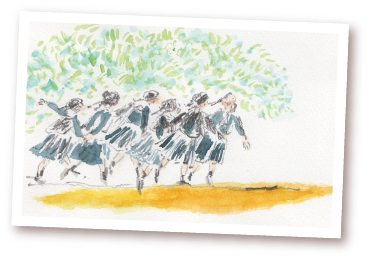言語 Language
Aboout Himeyuri Peace Museum
Foundation of the Himeyuri Peace Museum
The Battle of Okinawa lasted for more than 90 days, claiming the lives of more than 200,000 Japanese and Americans, including some 120,000 Okinawans.
While the U.S. regarded the Battle of Okinawa as a vital operation to secure the island as an “unsinkable or stationary aircraft carrier” to be used for the invasion of mainland Japan, the Japanese military planned to wage a “war of attrition” to drag the battle out for even one day longer in order to delay a U.S. forces assault on the mainland. Under this imperative, the Japanese forces defending Okinawa decided to adopt the tactic of fighting to the last man and planned an all-out mobilization of the prefectural people for that purpose. In the face of the impending American invasion of Okinawa, the Japanese forces stepped up nurse training at girls’ high schools in the prefecture, and when the U.S. forces finally landed on Okinawa, the Japanese military organized students into student nurse corps and dispatched them to the battlefield. There was no legal basis whatsoever for this mobilization of young students for a military purpose. Nonetheless, the Japanese army implement the program.
Late at night on the 23rd of March 1945, a total of 222 students and 18 teachers from the Okinawa Women’s Normal School and the First Prefectural Girls’ High School were ordered to join the medical units at the Haebaru Army Hospital. There were also teachers and students who were mobilized to units in other areas at the front.
With an unwavering faith in the eventual victory of their country, the students carried out their duties with no regard for their own safety under desperate circumstances in the midst of the raging battle, attending to the wounded, removing dead soldiers from the caves, and carrying medical supplies, food, water, and whatever else was needed to and from the hospital caves.
Toward the end of May, the Japanese forces retreated south from Shuri, and the medical units at the Okinawa Army Hospital in Haebaru and in other areas also withdrew. Already on the brink of disintegration, the Japanese forces issued orders to disband the student corps in the midst of heavy fighting on the Kyan Peninsula at the southernmost end of the island.
The young, defenseless students, thrown out of their caves but not allowed to surrender, now had to fend for themselves in a hellish storm of fire and steel as the U.S. forces quickly tightened their stranglehold on the Japanese forces on the peninsula. This increased the sacrifice of the student corps, claiming the lives of 136 out of the 240 who were mobilized to the Army Hospital and 91 in other areas. Eventually, a total of 227 students and teachers lost their lives.
Forty some odd years later, we still cannot forget the indescribable tragedy we witnessed and experienced, nor can we forget the horror of the militaristic education of that time that blinded us to truth, deprived us of our right to think and judge as individuals, and denied us even the right to live as decent human beings, finally herding us like animals onto a battlefield of certain death.
Today, memories of the battle are fast being washed away the passage of time and as post-war generations have formed the majority of our population. In addition, when we think of today’s international situation with increased threats of nuclear war, we are determined all the more to do our best to continue to tell our stories of war, and by so exposing the brutality and insanity of war, to never allow it to happen again in the future.
Firmly keeping that pledge in mind, the Himeyuri alumnae will continue to appeal for world peace and pray for the repose of the souls of those who perished, and for that purpose, we constructed the Himeyuri Peace Museum on this site with sincere encouragement and support from many individuals and organizations in and outside the prefecture.
July 23, 1989 (Partially amended in April 2021) Himeyuri Alumnae Association
The museum renovated the entire exhibition in April 2004 so that we can better communicate our message to the younger generations. A new plaza, the “Passage to Peace,” reflects our longing for peace and its continuation in the future.
April 13, 2004 Himeyuri Peace Foundation
The museum implemented its second renovation of the exhibits in April 2021. We hope that the new exhibits of the Himeyuri students’ wartime experience will help younger generations who might consider the war an event in the distant past understand the horrible reality of war, the beauty of life, and the incalculable value of peace.
April 12, 2021 Himeyuri Peace Foundation







